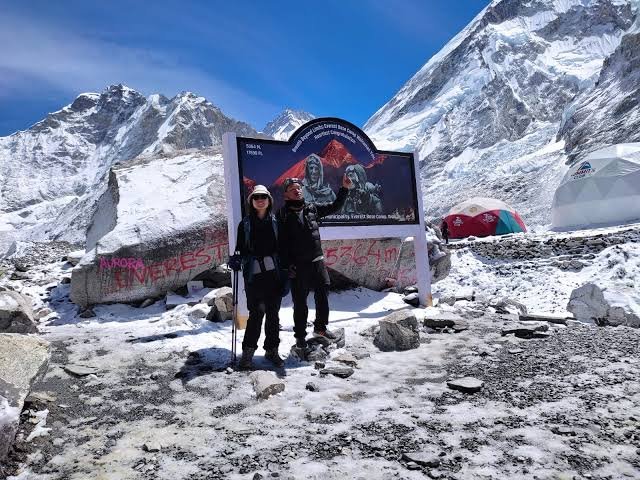Embarking on the Everest Base Camp Trek is more than just a journey; it’s a pilgrimage into the heart of the Himalayas that tests endurance, enriches the soul, and connects trekkers to a world of breathtaking grandeur. This trek, revered by adventurers from across the globe, offers an unparalleled opportunity to experience the majesty of Mount Everest, the highest peak on Earth, and to delve into the rich cultural tapestry of the Khumbu region.
The trek begins with an exhilarating flight from Kathmandu to Lukla, a dramatic start that sets the tone for the adventure ahead. As the aircraft descends onto Lukla’s famously short runway, the anticipation of the journey ahead is palpable. The initial days are filled with the excitement of traversing lush forests, crossing suspension bridges, and witnessing the traditional Sherpa villages that dot the landscape. Each village, with its vibrant prayer flags and welcoming tea houses, offers a glimpse into the daily life of the Sherpa people, whose warm hospitality and deep-rooted traditions enhance the trekking experience.
The real challenge of the trek begins as you ascend higher into the rugged terrain. The path to Everest Base Camp winds through a series of breathtaking vistas and diverse landscapes, including verdant valleys, alpine meadows, and stark, windswept plateaus. The trek is punctuated by dramatic views of towering peaks like Nuptse, Lhotse, and, of course, Everest itself. The sight of these colossal mountains emerging from the morning mist is both humbling and inspiring.
Acclimatization is a key aspect of the journey. Trekkers must heed the advice of their guides and listen to their bodies as they adjust to the thinning air. Rest days in places like Namche Bazaar and Dingboche are not just about recuperation but also about soaking in the surrounding splendor and interacting with local communities. These pauses allow trekkers to explore ancient monasteries, visit traditional markets, and savor the unique flavors of Tibetan cuisine.
Reaching Everest Base Camp is the culmination of days of rigorous trekking and altitude adjustment. The moment you step into the base camp, with Everest towering above and the surrounding peaks standing sentinel, the effort of the journey transforms into an overwhelming sense of achievement. The stark beauty of the glacier, the fluttering prayer flags, and the sheer magnitude of the environment create a profound connection to the natural world and to the spirit of adventure.
Descending back to Lukla brings a mix of relief and nostalgia. The trek back provides an opportunity to reflect on the experiences and challenges faced along the way. Each step carries a memory of the highs and lows, the camaraderie formed with fellow trekkers, and the silent majesty of the Himalayas that will linger long after the journey ends. Conquering Everest Base Camp is not just about reaching a physical destination; it’s about the personal growth and deep sense of fulfillment that comes from embracing one of the world’s most extraordinary trekking experiences.
Introduction: The Allure of Everest
The allure of Everest is undeniable, captivating adventurers and dreamers with its towering presence and mystique. As the highest peak on Earth, Mount Everest symbolizes the ultimate challenge and achievement in mountaineering and trekking. Its sheer grandeur and the formidable beauty of the surrounding Himalayas draw trekkers from all corners of the globe to its base camp. The 12 Days Everest Base Camp Trek offers a unique opportunity to witness this iconic peak up close, amidst the backdrop of the stunning Khumbu region. The trek combines physical challenge with spiritual fulfillment, as trekkers journey through dramatic landscapes, ancient Sherpa villages, and high-altitude terrain. The promise of breathtaking vistas, the chance to engage with local cultures, and the sheer adventure of reaching Everest’s base camp make it a coveted destination. The trek not only challenges one’s physical limits but also offers a profound connection to the natural world and a sense of accomplishment that is deeply rewarding. The allure of Everest lies in this blend of challenge, beauty, and cultural richness, making it an irresistible journey for those seeking adventure and inspiration.
Setting Out: Planning the Adventure
Planning an Everest Base Camp Trek requires meticulous preparation and foresight. The adventure begins with choosing the right time to trek, typically during the pre-monsoon (late April to early June) or post-monsoon (late September to early November) seasons for optimal weather conditions. Securing necessary permits, such as the Sagarmatha National Park Entry Permit and the TIMS Card, is essential for accessing the trek’s route. Booking flights to Lukla and arranging accommodation in Kathmandu are also crucial steps. Preparing for the physical demands of the trek involves engaging in cardiovascular and strength training exercises to build endurance and stamina. Additionally, packing appropriate gear, including sturdy trekking boots, layered clothing, and essential safety equipment, ensures comfort and preparedness for varying weather conditions and high-altitude challenges. Familiarizing oneself with the cultural and environmental aspects of the trek helps in planning respectful and responsible travel practices. By addressing these planning elements, trekkers set the stage for a successful and fulfilling Everest Base Camp adventure.
The Journey Begins: Day 1 Highlights
Day 1 of the Everest Base Camp Trek 11 Days marks the exciting start of an unforgettable adventure. The journey begins with a thrilling flight from Kathmandu to Lukla, landing at one of the world’s most scenic and precarious airstrips. This dramatic arrival sets the tone for the trek ahead. After landing, trekkers are greeted by the stunning views of the surrounding mountains and the bustling atmosphere of Lukla, a gateway town with a lively market and several teahouses. The trek officially starts with a descent through lush pine forests and across suspension bridges over the Dudh Koshi River. The first day’s trek is relatively short, leading to the village of Phakding. Here, trekkers can acclimate to the altitude and enjoy the serene environment of the Himalayas. The peaceful setting and the introduction to Sherpa culture, coupled with the anticipation of the journey ahead, make Day 1 a memorable and exciting beginning to the Everest Base Camp Trek.
Navigating the Trails: Key Stops
Navigating the trails of the Everest Base Camp Trek involves passing through several key stops, each offering unique experiences and crucial acclimatization opportunities. The trek begins from Lukla, moving through Phakding, where trekkers get their first taste of the Khumbu region’s beauty. The trail then leads to Namche Bazaar, the vibrant trading hub of the region and an essential acclimatization point. Namche Bazaar is known for its lively market, stunning mountain views, and opportunities to explore local culture. Continuing the journey, trekkers reach Tengboche, home to the famous Tengboche Monastery, which offers panoramic views of Everest and surrounding peaks. The trek progresses to Dingboche, another vital acclimatization stop, set against a backdrop of impressive peaks. Further along, Lobuche provides a gateway to the Everest Base Camp itself. Each of these stops plays a significant role in managing altitude, providing rest, and allowing trekkers to immerse themselves in the local environment and culture, making them integral to the overall trekking experience.
Challenges Faced on the Trek
The Everest Base Camp Trek presents a range of challenges that test the physical and mental endurance of trekkers. One of the primary challenges is the high altitude, which can lead to altitude sickness if not managed properly. The trek involves gradual elevation gain, but even with proper acclimatization, the thin air can cause symptoms like headaches, nausea, and fatigue. The rugged terrain adds another layer of difficulty, with steep ascents and descents, rocky paths, and potential weather hazards. Trekkers must also be prepared for variable weather conditions, including cold temperatures, strong winds, and the possibility of snow or rain. Physical conditioning is crucial, as long days of trekking require stamina and strength. Additionally, logistical challenges such as managing permits, arranging transportation, and dealing with limited accommodation options in remote areas can add to the trek’s complexity. Despite these challenges, careful preparation, perseverance, and a positive attitude enable trekkers to overcome obstacles and achieve the rewarding experience of reaching Everest Base Camp.
Experiences of Acclimatization
Acclimatization is a pivotal aspect of the Short Everest Base Camp Trek, crucial for adapting to the high-altitude environment and ensuring a safe and enjoyable journey. The process involves more than just physical adaptation; it requires a mindful approach to gradually increase altitude while allowing your body time to adjust. Key experiences during acclimatization include resting days in strategic locations like Namche Bazaar and Dingboche, where trekkers can explore and engage in gentle hikes to higher altitudes before returning to lower elevations for sleep. This method, known as “climb high, sleep low,” helps your body acclimate to the reduced oxygen levels. The trek’s itinerary is designed with these acclimatization stops to minimize the risk of altitude sickness. Common experiences include the gradual onset of symptoms such as headaches or breathlessness, which can be managed with proper hydration, nutrition, and rest. Trekkers often find these acclimatization days challenging but rewarding, as they provide a chance to adapt physically and mentally to the demands of high-altitude trekking. Overall, successful acclimatization is a blend of listening to your body, following expert advice, and pacing yourself throughout the journey.
Encounters with Local Culture
Encounters with local culture are a rich and integral part of the Everest Base Camp Trek, offering trekkers a deep connection to the Sherpa people and their traditions. As you trek through the Khumbu region, you pass through numerous Sherpa villages, each with its own unique cultural characteristics. In Namche Bazaar, the bustling market provides insight into traditional crafts, local foods, and vibrant community life. The Tengboche Monastery, an important spiritual center, offers a glimpse into Tibetan Buddhism through its rituals, prayer flags, and monastery architecture. Engaging with local Sherpas, who are renowned for their hospitality and resilience, allows trekkers to learn about their way of life, including their customs, festivals, and daily routines. Conversations with Sherpa guides and porters enrich the experience, offering personal stories and cultural insights. Respecting local customs, such as removing shoes before entering homes and monasteries, and participating in traditional ceremonies when invited, enhances your cultural immersion. These interactions not only deepen your understanding of the region but also foster mutual respect and appreciation between trekkers and the local communities.
Personal Reflections on the Trek
Personal reflections on the Everest Base Camp Trek often center on the transformative nature of the journey and the profound sense of accomplishment it brings. For many trekkers, the trek is a test of physical endurance, mental strength, and personal limits. Reflecting on the experience often highlights moments of struggle and triumph, from the physical challenge of steep ascents to the awe-inspiring views of Everest and the surrounding peaks. The trek provides an opportunity for introspection, as the solitude and grandeur of the Himalayas encourage contemplation and self-discovery. Many trekkers find that the journey fosters a deep sense of gratitude and perspective, reshaping their views on life and personal resilience. The shared camaraderie with fellow trekkers and the supportive interaction with Sherpa guides and porters also contribute to a sense of connection and community. These personal reflections underscore the trek’s impact beyond just reaching Everest Base Camp, revealing the journey’s lasting influence on one’s outlook and personal growth.
The Final Push to Base Camp
The final push to Everest Base Camp is a dramatic and emotionally charged part of the trek, characterized by a sense of anticipation and accomplishment. After days of trekking through varying landscapes and gradually acclimating to the altitude, the approach to Base Camp involves navigating the rugged terrain of Gorak Shep. This final stretch is both physically demanding and exhilarating, as trekkers traverse rocky paths and negotiate the challenging conditions of high altitude. The sight of Everest Base Camp, with its colorful array of tents and the iconic backdrop of the Khumbu Icefall, is a powerful reward for the effort invested. The ascent to Base Camp is often marked by a mix of exhaustion, exhilaration, and reflection on the journey’s trials and triumphs. The arrival at Base Camp signifies the culmination of weeks of trekking, and the moment is celebrated with a deep sense of pride and accomplishment. Standing at the foot of the world’s highest peak, trekkers experience a profound connection to the mountain and the adventure that brought them there.
Moments of Triumph and Transformation
Moments of triumph and transformation are central to the Everest Base Camp Trek, marking significant milestones and personal growth throughout the journey. The sense of triumph is palpable when reaching Everest Base Camp, where the culmination of physical effort, mental perseverance, and unwavering determination is celebrated against the backdrop of towering peaks. These moments often evoke a profound sense of achievement and satisfaction, as trekkers reflect on the challenges overcome and the goals achieved. The trek’s demanding conditions push individuals beyond their comfort zones, leading to transformative experiences that extend beyond the physical journey. Many trekkers find that the trek fosters inner strength, resilience, and a renewed perspective on life. The camaraderie with fellow trekkers and the support from Sherpa guides and porters further enhance the sense of transformation, as shared experiences and mutual encouragement create lasting bonds. These moments of triumph and transformation encapsulate the essence of the Everest Base Camp Trek, leaving trekkers with enduring memories and a deep appreciation for their journey.





